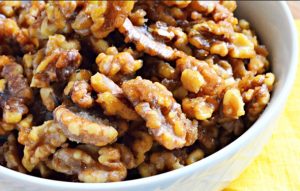Mama’s Punjabi Recipes: Gur Galef Kharot (Molasses Coated Walnuts)
By popular demand from many readers, below is a reprint of Mama’s Gur Galef Kharot recipe, which is a tasty sweet to make especially during the merry winter holiday season. It is reprinted with some additional information and directions.
Nuts of all types are a favorite of Punjabis, and especially piste (pistachios), badam (almonds), kharot (walnuts) or kaju (cashews). I remember when I was growing up in Lyallpur in the region of West Punjab made fertile by the Chenab River that my grandfather, Lalaji Mastan Chand Malhotra who was a Municipal Committee Secretary, would bring home jute bags full of nuts of all sorts. We would enjoy breaking and eating them during the winter months as we sat around an anghiti (wood burning clay bucket stove) in the courtyard of our ancestral home.
During the winter months in North India chilgoze (pine nuts) and sand-roasted moongfli (peanuts) are sold commonly by street vendors – and kharot (walnuts) and kishmish (raisins) are equally popular. These mewah (dried fruits) are very often used in all types of mithai (sweetmeats) like burfi (reduced milk squares) and ladoos (sweetened flour balls). Even though dried fruits are now quite expensive in India and are out of the reach of many people, the halwai (confectioners) shops are packed everyday.
Gajack (peanut brittle in gur (sugar cane jaggery)) is popular in the winter months in North India and is sold in the cities by rural farmers who come to the cities for a month to freshly make it in pop-up roadside stalls. Further south, the tourist town of Lonawala, southwest of Pune, is famous for gajack, with every other store in the main bazar selling the popular Maganlal chikki (as it is known there) brand.
Walnuts (kharot) are very beneficial: they contain the omega-3 amino acid I-arginine which fights heart disease; may reduce prostate and breast cancers; have powerful antioxidants, improve metabolism in people with type 2 diabetes and help with weight control, brain health and reproductive health in men.
During this Holiday Season, this timely recipe will come in handy because it is fairly easy to make and is hard to resist. Too many walnuts can irritate the palate but the gur coating makes them much tastier and is also not as heavy as other sweets are. In Texas, you can substitute pecans which are very popular, if you prefer.
Ingredients:
500gm kharott giri (shelled walnuts)
500gm gur (rock molasses)
¼ tsp saunf (fennel seed)
¼ cup pani (water)
Directions:
1. Chop the walnuts into halves so that they are easier to coat and eat.
2. Break the gur into smaller pieces. Place a frying pan over high heat, pour in the water and when it is nice and hot, throw in the gur pieces and let them melt.
3. Add the fennel seed and stir well for 5 minutes. Test the melted gur to see if it runs a sticky ribbon when stirred and touched.
4. Turn the heat off and throw in the walnut pieces and stir well and quickly to coat them and make sure the walnuts aren’t clumped together.
5. Place on a plate to let the walnuts cool off; when cool place in an air-tight jar so that they don’t become humid.
MAMA’S TIP OF THE WEEK
USE GUR (JAGGERY) THAT IS MADE OF DARK BROWN MOLASSES
In India, it is easy to find the right type of gur (jaggery) to make sweets and use in sweet and sour pickles. But in the US, most jaggery comes from Mexico and not all of it is made from sugar cane. In many stores, the Mexican jaggery is sold in conical shapes, and is usually light colored, and some is even just compacted sugar with a hint of molasses.
For best results, buy the Indian gur that is sold as a large, squat cylinder and has a deep brown color. Make sure it says it is made from sugar cane molasses. You can break off a piece for cooking and then keep the rest sealed in a plastic bag and container for use later.

Shakuntla Malhotra is a skilled cook of Punjabi dishes made in the old-fashioned style that she learnt as a young woman in her ancestral home in Lyallpur (since renamed Faisalabad), India before it became part of Pakistan after the Partition in 1947. People have often admired her cooking for its simplicity and taste that comes with each mouthful. Even in her mid-eighties, she continues to cook daily and agreed to share some of her delectable Punjabi recipes

